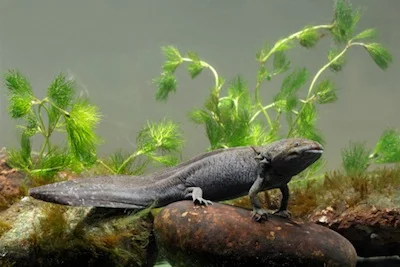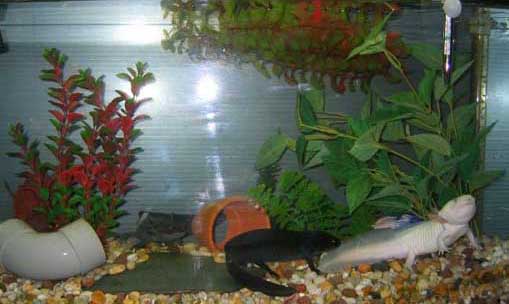Axolotls live in water but they are not fish.
They breathe through gills that look like feathers.
They have four legs and a tail.
They come in different colours.
They are covered in skin, not scales.
A black axolotl © Getty Images
What is an axolotl?
The axolotl is the young, or larva, of a type of salamander.
Its wild habitat is in high-altitude lakes near Mexico City, Chalco and Xochimilco. Sadly, Lake Chalco has dried up, leaving only Lake Xochimilco.
Axolotls are often incorrectly called 'Mexican walking fish', but they are not fish. They belong to a group of amphibians called salamanders. There are different species (kinds) of salamander. Salamanders are amphibians that that breathe through lungs and live on land. They look a bit like lizards except that they are covered with a soft moist skin, not scales, and their larvae, called axolotls, look a bit like large tadpoles with feathers on their necks.
Amazingly, the axolotl (say: ax-uh-lot-ll) can stay as a larva, living its whole life in the water without ever changing into a grown up salamander, and can breed in this larval stage. However, if the water level drops so that the feathery gills are above water for a length of time, it begins to change into a salamander, which breathes through lungs and lives on land. There are ten stages of development, but if the water level rises during the first five stages, it goes back to its larval stage. If the water rises after the fifth stage, the change to becoming an salamander continues.
Axolotls come in many colours, including white, but in the wild black is the most common colour. They grow to between 20-40 cm.
A unique feature of the axolotl
A unique feature of the axolotl is called regeneration (say ree-jen-uh-ray-shun). This means that it can grow back body parts that are injured or bitten off by a predator or another axolotl. They can grow back legs or tail, and even parts of the brain or heart. Incredibly, a broken spine will heal and resume all its important functions. For this reason, scientists study the axolotl, hoping to find out what gives them this ability and if it can be reproduced in human injuries.
What is an amphibian?
A red salamander ©Getty Images
Amphibians lay eggs in water, and the young that hatch from the eggs are called larvae: one is a larva, lots are larvae (say lah-vay). The larvae live completely in the water, breathing through gills. Then they change into adults and live on land, breathing through lungs and skin. Frogs are the best-known amphibians.
Breathing
The gills look like feathers. © Getty Images
An axolotl has three pairs of feather-like gills at the back of its head. As water passes through the gills, the axolotl takes in the oxygen from it.
They do have lungs, but breathe through their gills and through their skin. From time to time an axolotl will come to the water surface to gulp a breath of air.
Axolotls can be kept as pets in an aquarium. ©Getty Images
Housing and care of a pet axolotl
Axolotls are popular pets and can be housed in an aquarium. One or two axolotls of about the same size can be kept in the same tank but make sure there is plenty of room for the animals to move about.
An axolotl sheltering in a flower pot shelter in its tank. ©Getty Images
Put in plants, and place a rock, plastic pipe or even a flower pot on its side in the tank so they have a place where they can hide. The tank water should be filtered, and changed from time to time and the glass cleaned. Aquarium fish may bite at the axolotl's gills, and axolotls may eat the fish, so it is best to not put fish and axolotls together in the tank.
Diet
Axolotls are carnivores, which means they eat meat. They find their food by seeing movement and by scent. A pet axolotl can be fed earthworms, soft insects, brine shrimp (sea monkeys) or tiny pieces of meat. Some axolotls will eat fish food pellets. Because their eyesight is poor, they can be fed by hand. They need only be fed every two or three days. Any uneaten food should be removed from the water or it will go bad and make the axolotls sick.
Life cycle
Axolotls don't walk around on land - the photo doesn't show the water so we can see the gold colour. ©Getty Images
Axolotls can breed while remaining in the larva stage - this unusual ability is called 'neotony'. Scientists have found thatneotony is for survival in the wild when the water high in the mountains is lacking in iodine, which they need to help them transform, or metamorphose. In particular, when there is little food available, staying as a larva requires less food than a salamander. Then, when the water is rich in iodine and food, there are enough larva to change and ensure the species of salamander continues.
Axolotls can breed when they are about 6 months old. The male axolotl deposits packets of his sperm and then leads the female over them. She takes some of the sperm into her body through an opening called a cloaca. Inside her body the sperm mixes with her eggs. In the next day or two the female lays her eggs on leaves of plants or on rocks. When they hatch, in about two weeks time, young axolotls emerge.
A white axolotl with pink pebbles in its tank. ©Getty Images
They are about a centimetre long and look like tadpoles with legs. Axolotls can live for more than 10 years in captivity.
Conservation Status
Although they are popular pets and are bred for sale as pets, axolotls have become very rare in the wild.
Axolotls are listed as Critically Endangered in the Wild.
There are several reasons for this, including pollution and the introduction of non-native fish into their habitat. They were also caught by people for use as food and medicine. There are now more axolotls living as pets or in laboratories than in the wild.
Conservationists and scientists are working with the Mexican government to save the axolotl in the wild.
If you have axolotl pets, be a responsible pet owner
Pet axolotls depend on their owners for food, protection and shelter. Before becoming a pet owner think carefully about all the things you will have to do to care for your pet responsibly.
Watch a video:
https://www.youtube.com/watch?v=uQi-yDXBn9c
Read more about axolotls:
http://a-z-animals.com/animals/axolotl/








